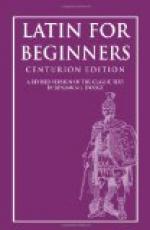229. THE FAITHLESS TARPEIA (Concluded)[2]
Tarpeia, commota ornamentis Sabinorum pulchris, diu resistere non potuit et respondit: “Date mihi[3] ornamenta quae in sinistris bracchis geritis, et celeriter copias vestras in Capitolium ducam.” Nec Sabini recusaverunt, sed per duras magnasque castelli portas properaverunt quo[1] Tarpeia duxit et mox intra validos et altos muros stabant. Tum sine mora in[2] Tarpeiam scuta graviter iecerunt; nam scuta quoque in sinistris bracchiis gerebant. Ita perfida puella Tarpeia interfecta est; ita Sabini Capitolium occupaverunt.
[Footnote 2: Explain the use of the tenses in this selection.]
[Footnote 3: to me.]
[Footnote 1: quo = whither,
to the place where. Here quo\ is
the relative adverb.
We have had it used before as the interrogative
adverb, _whither?_ _to what
place?_]
[Footnote 2: upon.]
LESSON XXXIX
THE THIRD DECLENSION : CONSONANT STEMS
[Special Vocabulary]
barbarus, -a, -um\, _strange, foreign,
barbarous_. As a noun,
barbari:, -o:rum\, m.,
plur., savages, barbarians
dux, ducis\, m., _leader_ (duke).
Cf. the verb du:co:\
eques, equitis\, m., _horseman, cavalryman_
(equestrian)
iu:dex, iu:dicis, _m., judge_
lapis, lapidis\, m., stone
(lapidary)
mi:les, mi:litis\, m., _soldier_ (militia)
pedes, peditis\, m., foot soldier
(pedestrian)
pe:s, pedis\,[A] m., _foot_ (pedal)
pri:nceps, pri:ncipis\, m., chief
(principal)
re:x, re:gis\, m., _king_ (regal)
summus, -a, -um\, highest, greatest
(summit)
virtu:s, virtu:tis\, f., _manliness,
courage_ (virtue)
[Footnote A: Observe
that e\ is _long_ in the nom. sing, and
_short_ in the other cases.]
230. Bases and Stems. In learning the first and second declensions we saw that the different cases were formed by adding the case terminations to the part of the word that did not change, which we called the base\. If to the base we add -a: in the first declension, and -o in the second, we get what is called the stem\. Thus porta\ has the base port- and the stem porta:-; servus\ has the base serv- and the stem servo-.
These stem vowels, -a:- and -o-, play so important a part in the formation of the case terminations that these declensions are named from them respectively the A- and O-Declensions.
231. Nouns of the Third Declension. The third declension is called the Consonant or I-Declension, and its nouns are classified according to the way the stem ends. If the last letter of the stem is a consonant, the word is said to have a consonant stem; if the stem ends in -i-, the word is said to have an i-stem. In consonant stems the stem is the same as the base. In i-stems the stem is formed by adding -i- to the base. The presence of the i\ makes a difference in certain of the cases, so the distinction is a very important one.




